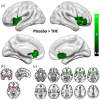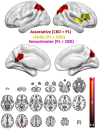Individual and combined effects of cannabidiol and Δ9-tetrahydrocannabinol on striato-cortical connectivity in the human brain
- PMID: 35596578
- PMCID: PMC9150138
- DOI: 10.1177/02698811221092506
Individual and combined effects of cannabidiol and Δ9-tetrahydrocannabinol on striato-cortical connectivity in the human brain
Abstract
Background: Cannabidiol (CBD) and Δ9-tetrahydrocannabinol (THC) are the two major constituents of cannabis with contrasting mechanisms of action. THC is the major psychoactive, addiction-promoting, and psychotomimetic compound, while CBD may have opposite effects. The brain effects of these drugs alone and in combination are poorly understood. In particular, the striatum is implicated in the pathophysiology of several psychiatric disorders, but it is unclear how THC and CBD influence striato-cortical connectivity.
Aims: To examine effects of THC, CBD, and THC + CBD on functional connectivity of striatal sub-divisions (associative, limbic and sensorimotor).
Method: Resting-state functional Magnetic Resonance Imaging (fMRI) was used across two within-subjects, placebo-controlled, double-blind studies, with a unified analysis approach.
Results: Study 1 (N = 17; inhaled cannabis containing 8 mg THC, 8 mg THC + 10 mg CBD or placebo) showed strong disruptive effects of both THC and THC + CBD on connectivity in the associative and sensorimotor networks, but a specific effect of THC in the limbic striatum network which was not present in the THC + CBD condition. In Study 2 (N = 23, oral 600 mg CBD, placebo), CBD increased connectivity in the associative network, but produced only relatively minor disruptions in the limbic and sensorimotor networks.
Outcomes: THC strongly disrupts striato-cortical networks, but this effect is mitigated by co-administration of CBD in the limbic striatum network. Oral CBD administered has a more complex effect profile of relative increases and decreases in connectivity. The insula emerges as a key region affected by cannabinoid-induced changes in functional connectivity, with potential implications for understanding cannabis-related disorders, and the development of cannabinoid therapeutics.
Keywords: CBD; Cannabinoids; THC; cannabis; fMRI; resting-state.
Conflict of interest statement
Figures





Similar articles
-
Dissociable effects of cannabis with and without cannabidiol on the human brain's resting-state functional connectivity.J Psychopharmacol. 2019 Jul;33(7):822-830. doi: 10.1177/0269881119841568. Epub 2019 Apr 23. J Psychopharmacol. 2019. PMID: 31013455 Clinical Trial.
-
Opposite Roles for Cannabidiol and δ-9-Tetrahydrocannabinol in Psychotomimetic Effects of Cannabis Extracts: A Naturalistic Controlled Study.J Clin Psychopharmacol. 2021 Sep-Oct 01;41(5):561-570. doi: 10.1097/JCP.0000000000001457. J Clin Psychopharmacol. 2021. PMID: 34412109 Clinical Trial.
-
Effects of cannabinoids on resting state functional brain connectivity: A systematic review.Neurosci Biobehav Rev. 2023 Feb;145:105014. doi: 10.1016/j.neubiorev.2022.105014. Epub 2022 Dec 20. Neurosci Biobehav Rev. 2023. PMID: 36563921
-
A randomised controlled trial of vaporised Δ9-tetrahydrocannabinol and cannabidiol alone and in combination in frequent and infrequent cannabis users: acute intoxication effects.Eur Arch Psychiatry Clin Neurosci. 2019 Feb;269(1):17-35. doi: 10.1007/s00406-019-00978-2. Epub 2019 Jan 19. Eur Arch Psychiatry Clin Neurosci. 2019. PMID: 30661105 Clinical Trial.
-
Clinical and Preclinical Evidence for Functional Interactions of Cannabidiol and Δ9-Tetrahydrocannabinol.Neuropsychopharmacology. 2018 Jan;43(1):142-154. doi: 10.1038/npp.2017.209. Epub 2017 Sep 6. Neuropsychopharmacology. 2018. PMID: 28875990 Free PMC article. Review.
Cited by
-
The effects of standardized cannabis products in healthy volunteers and patients: a systematic literature review.Front Pharmacol. 2024 Oct 17;15:1411631. doi: 10.3389/fphar.2024.1411631. eCollection 2024. Front Pharmacol. 2024. PMID: 39484170 Free PMC article.
-
Acute effects of different types of cannabis on young adult and adolescent resting-state brain networks.Neuropsychopharmacology. 2024 Sep;49(10):1640-1651. doi: 10.1038/s41386-024-01891-6. Epub 2024 May 28. Neuropsychopharmacology. 2024. PMID: 38806583 Free PMC article. Clinical Trial.
-
Delta-9-Tetrahydrocannabinol, Cannabidiol, and Acute Psychotomimetic States: A Balancing Act of the Principal Phyto-Cannabinoids on Human Brain and Behavior.Cannabis Cannabinoid Res. 2023 Oct;8(5):846-856. doi: 10.1089/can.2021.0166. Epub 2022 Mar 18. Cannabis Cannabinoid Res. 2023. PMID: 35319274 Free PMC article. Clinical Trial.
-
Edible cannabis for chronic low back pain: associations with pain, mood, and intoxication.Front Pharmacol. 2024 Sep 24;15:1464005. doi: 10.3389/fphar.2024.1464005. eCollection 2024. Front Pharmacol. 2024. PMID: 39380911 Free PMC article.
-
Assessing rates and predictors of cannabis-associated psychotic symptoms across observational, experimental and medical research.Nat Ment Health. 2024;2(7):865-876. doi: 10.1038/s44220-024-00261-x. Epub 2024 Jun 3. Nat Ment Health. 2024. PMID: 39005547 Free PMC article.
References
Publication types
MeSH terms
Substances
Grants and funding
LinkOut - more resources
Full Text Sources

